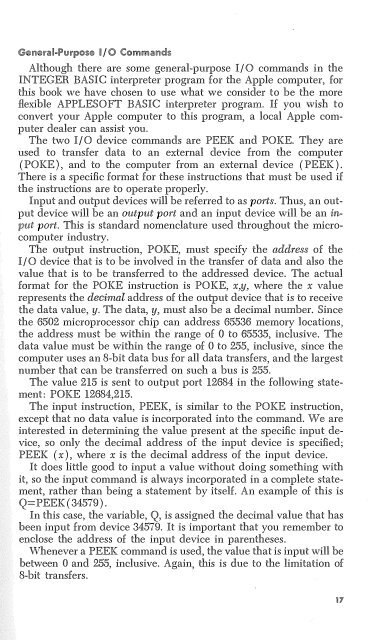Create successful ePaper yourself
Turn your PDF publications into a flip-book with our unique Google optimized e-Paper software.
Gei'!eral-fi!Jrp@S('; I/ 0 Commaru:li:><br />
Although there are some general-purpose I/0 commands in the<br />
INTEGER BASIC interpreter program for the Apple computer, for<br />
this book we have chosen to use what we consider to be the more<br />
flexible APPLESOFT BASIC interpreter program If you wish to<br />
convert your Apple computer to this program, a local Apple computer<br />
dealer can assist you.<br />
The two If 0 device commands are PEEK and POKE. They are<br />
used to transfer data to an external device from the computer<br />
(POKE), and to the computer from an external device (PEEK).<br />
There is a specific format for these instrnctions that must be used if<br />
the instructions are to operate properly.<br />
Input and output devices will be referred to as ports. Thus, an output<br />
device will be an output port and an input device will be an inport.<br />
This is standard nomenclature used throughout the microcomputer<br />
industry.<br />
The output instruction, POKE, must specify the address of the<br />
I/0 device that is to be involved in the transfer of data and also the<br />
value that is to be transferred to the addressed device. The actual<br />
format for the POKE instruction is POKE, x,y, where the x value<br />
represents the decimal address of the output device that is to receive<br />
the data value, y. The data, y, must also be a decimal number. Since<br />
the 6502 microprocessor chip can address 65536 memory locations,<br />
the address must be within the range of 0 to 65535, inclusive. The<br />
data value must be within the range of 0 to 255, inclusive, since the<br />
computer uses an 8-bit data bus for all data transfers, and the largest<br />
number that can be transferred on such a bus is 255.<br />
The value 215 is sent to output port 12684 in the following statement:<br />
POKE 12684,215.<br />
The input instruction, PEEK, is similar to the POKE instruction,<br />
except that no data value is incorporated into the command. VVe are<br />
interested in determining the value present at the specific input device,<br />
so only the decimal address of the input device is specified;<br />
PEEK ( x), where x is the decimal address of the input device.<br />
It does little good to input a value without doing something with<br />
it, so the input command is always incorporated in a complete statement,<br />
rather than being a statement by itself. An example of this is<br />
Q= PEEK ( 34579) .<br />
In this case, the variable, Q, is assigned the decimal value that has<br />
been input from device 34579. It is important that you remember to<br />
enclose the address of the input device in parentheses.<br />
Whenever a PEEK command is used, the value that is input will be<br />
between 0 and 255, :inclusive. Again, this is due to the limitation of<br />
8-bit transfers.<br />
l )'

















